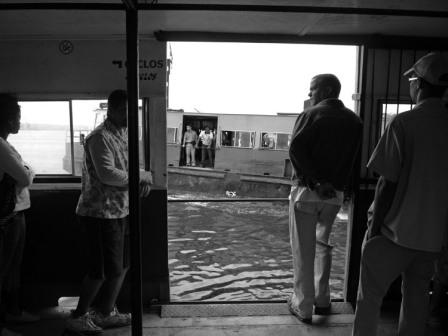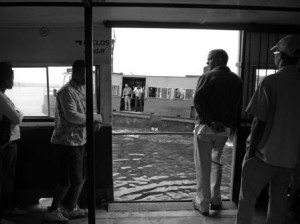
A lesson from Cuba on race
By Alejandro de la Fuente
In a recent article for The Stone, Gary Gutting posed a challenge. He urged readers to look “past the outrage on race” provoked by the Trayvon Martin case and to focus on what he aptly described as the “deeper issue” that sustains the edifice of racial inequality — our unjust economic system. Under this system, people compete for basic goods and services in what seems to be a fair and non-discriminating market. But since they enter this market from vastly different social circumstances, competition is anything but fair. Those who already possess goods have a much better chance of renewing their access to them, whereas those who don’t have little chance of ever getting them.

Gutting asks the right questions. If issues of economic justice are at the root of racial problems, what are the policy implications of this realization? Are such policies compatible with or even possible in a capitalist system? Is capitalism inexorably unjust? It is tempting for people of any country — and perhaps especially the United States — to view the conditions of their political and public life as unique. But of course, other multiracial societies have grappled with similar problems. It is frequently overlooked that the race problems in the United States are, in fact, not just ours, but part of a much larger story of racial differentiation and discrimination in the Americas. Less than 10 percent of the Africans forcibly transported to the New World came to what is now the United States. Most people of African descent in the hemisphere do not live here, but in Latin America and the Caribbean. Have any of these societies had the sort of debate that Gutting suggests? Have they tried to answer his questions concerning economic justice?
Few in the United States would think to turn to a socialist state for wisdom on the matter, but an examination of the recent history of Cuba does in fact provide valuable lessons about the complex links between economic justice, access to basic goods and services, racial inequality, and what Gutting refers to as “continuing problems about race.”
The Cuban answer to the deep issue of social justice is well known. After the revolution of 1959, Cuban authorities believed that capitalism was unable to correct social injustices like racism. Beginning in the early 1960s, the Cuban government nationalized vast sectors of the economy, dismantled market-driven mechanisms of resource allocation, introduced central economic planning, and guaranteed the egalitarian distribution of basic goods through a rationing system. At the same time, the socialization of educational, health care and recreational facilities democratized access to social and cultural services. If by economic justice we mean egalitarian access to basic goods and services such as food, health, housing, employment and education, then Cuba came closer than any other country in our hemisphere to fulfilling this ideal.
The enthusiasm generated by these changes was perhaps captured best by the African American writer and activist Julian Mayfield, author of an article about the impact of the Cuban revolution on race, published in October of 1960 in the newspaper The Afro-American. Its title was graphic enough: “Cuba Has Solution to Race Problem.”
According to research that I conducted in the 1990s for my book “A Nation for All: Race, Inequality and Politics in Twentieth-Century Cuba,” the economic and social programs promoted by the Cuban government produced dramatic results. By the early 1980s, when reliable data to measure the impact of such programs became available, inequality according to race had declined noticeably in a number of key indicators. The life expectancy of nonwhite Cubans was only one year lower than that of whites; life expectancy was basically identical for all racial groups. A powerful indicator of social wellbeing, linked to access to health services (as reflected, particularly, in infant mortality), nutrition and education, the Cuban race gap in life expectancy was significantly lower than those found in more affluent multiracial societies such as Brazil (about 6.7 years) and the United States (about 6.3 years) during the same period.
Racial differences in education and employment had also diminished or, in some cases, even disappeared. The proportion of high school graduates was actually higher among blacks than among whites in Cuba, whereas the opposite was true in both Brazil and the United States. Whites continued to enjoy an advantage at the college level, but it was minuscule. About 4.4 percent of white adults (25 or older) had a college degree, compared to 3.5 for those counted as black in the census or 3.2 for those counted as mestizos or mixed race. Meanwhile, in the United States the proportion of white college degree holders (20.5 percent) was twice as large as among blacks (10.7 percent); in Brazil it was nine times larger among whites (9.2 percent) than among blacks (1 percent).
Advances in education translated into impressive gains in the occupational structure. The proportion of nonwhites employed in professional services was similar to the proportion of whites. The same was true about retail, a sector that prior to 1959 had been basically out of reach for most Afro-Cubans. A national survey of people in managerial positions conducted in 1986 found that, although whites were overrepresented, the racial gap was very small. The proportion of blacks in manual labor activities in construction and manufacturing continued to be larger than whites’ and blacks were also poorly represented in some of the upper echelons of government. But, particularly in comparison to other multiracial societies in the Americas, the Cuban occupational structure was significantly less unequal according to race. On top of that, salaries in the massive public sector (over 90 percent of employment at the time) were regulated by law, so income differences were also extremely low.
I do not mean to claim that the Cuban revolution had created a socialist paradise in the tropics. Cuban society had numerous and profound problems. My point is that, in terms of what Gutting calls the “deeper issue” behind racial problems and divisions, Cuba had advanced a great deal, dismantling key pillars of inequality and providing more or less egalitarian access to education, health, employment and recreation.
Yet the Cubans were not able to go past their own “outrage on race.” Despite the massive changes discussed here, blackness continued to be associated with negative social and cultural features. Black was still ugly. Black still meant deficit of culture and refinement, rates of schooling notwithstanding. Black was still associated with violence, rape, robbery, crime. Black continued to be black. The justice system kept criminalizing black youths, sending a scandalous number of them to prison. In this regard, Cuba looked very much like the United States. We do not have good empirical data on this issue, but every available report and testimony confirms that in the 1980s blacks represented the vast majority of the inmate population in Cuba.
A study I conducted in 1987 (I lived in Cuba at the time) illustrates how racist perceptions could have devastating consequences for Afro-Cubans. This study dealt with “social dangerousness,” a legal figure that the Cuban Criminal Code defined as conducts that, although not constitutive of a crime per se, suggested “a special proclivity” to break the law and were “manifestly against the norms of socialist morality.” Those found to be “dangerous” could be deprived of freedom even without committing acts defined as crimes by the law. In other words, this was a legal institution particularly vulnerable to the influence of preconceptions and stereotypes. The conclusions of this study, which was never made public, were devastating: whereas nonwhites represented 34 percent of the adult population as a whole, their proportion among the socially “dangerous” was a staggering 78 percent. For each white person facing charges of social dangerousness, there were 5,430 white adults living in the city. Among blacks (excluding mestizos) the ratio was one in just 713.
In other words, despite Cuba’s success in reducing racial inequality, young black males continued to be seen as potential criminals. Perceptions of people of African descent as racially differentiated and inferior continued to permeate Cuban society and institutions. The point is not that issues of economic justice and access to resources are irrelevant. Eliminating massive inequality is a necessary step if we are ever going to dismantle racial differences. There is, as Gutting argues, a deeper issue of access to basic resources that does need solution. But the Cuban experience suggests that there are other equally deep issues that need to be addressed as well.
Those issues relate to what another writer here, George Yancy, in writing about the Trayvon Martin case, referred to as a “white gaze” that renders all black bodies dangerous and deviant. Unless we dismantle this gaze and its centuries-strong cultural pillars, it will be difficult to go past the outrage on race.
Alejandro de la Fuente is the director of the Afro-Latin American Research Institute at Harvard University’s Hutchins Center for African and African American Research. He is the author of “A Nation for All: Race, Inequality and Politics in Twentieth-Century Cuba.”
(From The New York Times)

